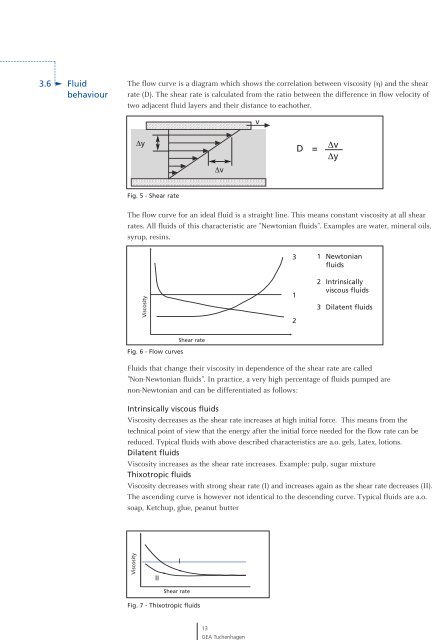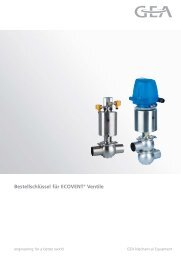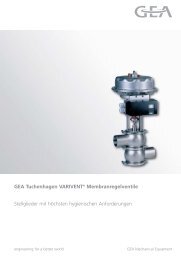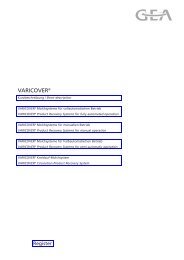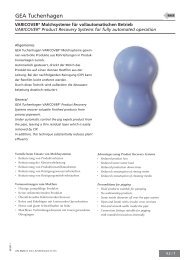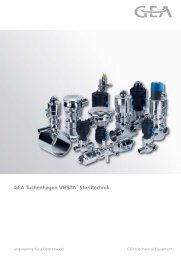Manual for the Design of Pipe Systems and Pumps - GEA ...
Manual for the Design of Pipe Systems and Pumps - GEA ...
Manual for the Design of Pipe Systems and Pumps - GEA ...
You also want an ePaper? Increase the reach of your titles
YUMPU automatically turns print PDFs into web optimized ePapers that Google loves.
3.6 Fluid<br />
behaviour<br />
The flow curve is a diagram which shows <strong>the</strong> correlation between viscosity (η) <strong>and</strong> <strong>the</strong> shear<br />
rate (D). The shear rate is calculated from <strong>the</strong> ratio between <strong>the</strong> difference in flow velocity <strong>of</strong><br />
two adjacent fluid layers <strong>and</strong> <strong>the</strong>ir distance to eacho<strong>the</strong>r.<br />
The flow curve <strong>for</strong> an ideal fluid is a straight line. This means constant viscosity at all shear<br />
rates. All fluids <strong>of</strong> this characteristic are "Newtonian fluids". Examples are water, mineral oils,<br />
syrup, resins.<br />
Fig. 6 - Flow curves<br />
Fluids that change <strong>the</strong>ir viscosity in dependence <strong>of</strong> <strong>the</strong> shear rate are called<br />
"Non-Newtonian fluids". In practice, a very high percentage <strong>of</strong> fluids pumped are<br />
non-Newtonian <strong>and</strong> can be differentiated as follows:<br />
Intrinsically viscous fluids<br />
Viscosity decreases as <strong>the</strong> shear rate increases at high initial <strong>for</strong>ce. This means from <strong>the</strong><br />
technical point <strong>of</strong> view that <strong>the</strong> energy after <strong>the</strong> initial <strong>for</strong>ce needed <strong>for</strong> <strong>the</strong> flow rate can be<br />
reduced. Typical fluids with above described characteristics are a.o. gels, Latex, lotions.<br />
Dilatent fluids<br />
Viscosity increases as <strong>the</strong> shear rate increases. Example: pulp, sugar mixture<br />
Thixotropic fluids<br />
Viscosity decreases with strong shear rate (I) <strong>and</strong> increases again as <strong>the</strong> shear rate decreases (II).<br />
The ascending curve is however not identical to <strong>the</strong> descending curve. Typical fluids are a.o.<br />
soap, Ketchup, glue, peanut butter<br />
Viscosity<br />
Δy<br />
Fig. 5 - Shear rate<br />
Viscosity<br />
II<br />
Shear rate<br />
Shear rate<br />
Fig. 7 - Thixotropic fluids<br />
I<br />
Δv<br />
13<br />
<strong>GEA</strong> Tuchenhagen<br />
v<br />
3 1 Newtonian<br />
fluids<br />
1<br />
2<br />
D = Δv<br />
Δy<br />
2 Intrinsically<br />
viscous fluids<br />
3 Dilatent fluids


